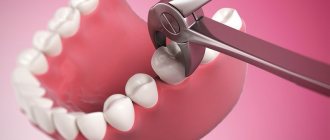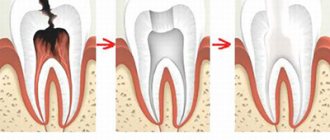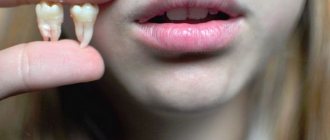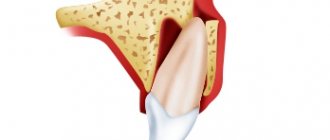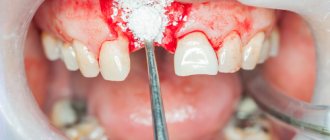Tooth depulpation is an endodontic manipulation to remove the neurovascular bundle from the tooth cavity and/or tooth roots. When is tooth removal necessary?
Depulpation of diseased teeth is carried out when the dental pulp is inflamed, due to the penetration of caries through the walls of the tooth to the intrapulp chamber. Through the carious gap created in the enamel and dentin, microbes and toxins enter the pulp, and the death of nerve fibers and capillaries of the pulp begins. Severe pain occurs when the tooth comes into contact with temperature and chemical irritants, i.e. for cold, hot, sour, sweet, etc.
Depulpation of teeth for prosthetic purposes
For grinding for a crown or dental bridge, the teeth are first depulped. High-quality depulpation (depulpation) of intact teeth allows you to avoid inflammatory processes (cysts and granulomas) under the root of the tooth on which the crown is installed. A non-pulp tooth under a crown can cause severe pain due to inflammation of the pulp.
How does pulp removal occur?
The process of depulpation allows you to stop the penetration of infection from the crown and root parts of the tooth under the apex, behind the root of the tooth, into the bone tissue surrounding the tooth. Thus, timely tooth depulpation prevents complications such as periodontitis , cysts or dental granuloma from developing. There are complete removal of the tooth pulp (from the roots and from the coronal part of the tooth) - pulp extirpation, and incomplete removal of the pulp (only from the coronal part of the tooth) - pulp amputation. Pulp amputation is carried out in the initial stage of pulpitis in order to preserve viable pulp in the root canals of the tooth.
What is depulpation and what is its essence?
What does tooth depulpation mean? Let's break the word down into parts - “de” means “removal”, and “pulp” refers to the soft neurovascular bundle that is located inside the tooth cavity and in the root canals. That is, depulpation or depulpation is the removal of the so-called “dental nerve”. After which the “empty” areas are filled with filling mass or pins, and then closed with crowns, inlays or special fasteners for dentures. Depulpation[1] is irreversible, i.e. a new pulp does not form in place of the removed one. Dental tissues cease to receive nutrition from the inside, and the tooth itself is considered “dead.” But this does not mean at all that it will fall out soon.
Any dentist should be able to carry out this procedure, but in the field of work this is most often done by dental therapists or more specialized specialists - endodontists. That is, if a patient comes to an orthopedist for a prosthesis, then if pulp removal is necessary, he will refer the person to a dentist-therapist.
Causes of dental pulp damage
The dentist is often visited because of caries - damage and destruction of enamel, which at the initial stage causes aesthetic discomfort.
Important: if the disease is started, the process affects the deeper layers of the tooth and pulpitis develops, that is, the neurovascular bundle becomes inflamed.
Pathologies arise due to the rapid proliferation of microbes, but in addition, the pulp can be damaged for the following reasons:
- gum disease, in which the neck of the tooth is exposed, the bone tissue is destroyed and harmful bacteria penetrate inside;
- trauma, as a result of which part of the tooth can break off, and then microbes enter the resulting cavity;
- mistake by the dentist who installed the filling or crown. If some actions were incorrect, then the nerve will make itself felt after a while.
These are the main causes of pulp damage. The symptoms of this condition will be acute. The pulp will begin to react to cold, hot, too spicy, sweet foods. Removing the nerve in such situations is a necessity, despite the fact that minerals and nutrients will stop flowing to the tooth.
What is the purpose of depulpation?
The goal of the procedure is to achieve several important results that will allow the patient to wear the prosthesis for a long time. Moreover, during the entire period of wearing the person will not be bothered by pain and the need to remove, for example, a crown. Let's take a closer look at what effect should be achieved:
- the pulp will not overheat during grinding of the stump and, accordingly, will not become inflamed (i.e., pulpitis will not appear under the crown),
- cariogenic bacteria will not penetrate into the pulp (i.e., pulpitis is again excluded),
- It will be possible to place pins or a core inlay into the canals: this will strengthen the restoration, i.e. it will last longer.
Don't know what type of prosthetics to choose?
We will help in the selection, advise where to read more information and compare types of prosthetics.
Consultation with an orthopedic doctor in Moscow clinics is free! Call now or request a call
Working hours: from 9:00 to 21:00 - seven days a week
When a nerve must be removed - indications
Whether tooth depulpation is necessary before prosthetics or not, only a doctor can say after a thorough examination - instrumental and x-ray. Mandatory removal of the dental nerve is necessary for the following indications:
- there are signs of pulpitis, i.e. inflammatory process of the pulp: pain, darkening of the deep layers of dentin,
- the top of the tooth is severely damaged,
- the natural crown has massive fillings,
- the patient often experiences relapses of caries,
- it is planned to install a crown with thick walls (for example, metal-ceramic): in this case, it is necessary to sharpen the stump quite strongly, which will lead to thinning of the dentinal layer (i.e., the pulp underneath will be less protected) and to its potential overheating during treatment with a drill. As a result, if depulpation is not performed, the risk of pulpitis increases and the time for re-prosthetics approaches.
Why do you need to remove the pulp?
We talked about the main reasons why nerve inflammation occurs, but most often pulpitis becomes a consequence of advanced caries. Therefore, it is very important to visit a dentist, even if nothing bothers you. The decision to remove the pulp is made in the following situations:
- pulpitis has passed into the stage of periodontitis, when inflammation affects the whole complex of connective tissue in the tooth;
- large area of carious lesion;
- the infection spreads through the apex of the tooth root;
- the appearance of unbearable, prolonged pain;
- spread of infection under an artificial crown;
- consequences of improper treatment.
The nerve can be removed either completely or partially, it all depends on the degree of tissue damage. Depulpation will prevent the spread of the inflammatory process under the crown and preserve the natural tooth, which is a priority for endodontic therapy.
When can you do without deletion?
Let's consider situations when depulpation can be abandoned, i.e. do not perform it before prosthetics:
- the stump (ground tooth tip) has thick walls,
- the pulp is not inflamed,
- in the future there is no risk of caries/pulpitis under the denture,
- overheating of dentin and pulp is excluded.
For veneers and restorative inlays, you can, in principle, do without depulpation altogether, as well as for thin ceramic crowns - but only if all the requirements just outlined are met.
What happens to a pulpless tooth?
Depulpation significantly reduces the risk of complications, but it has its drawbacks.
- Change in enamel color. Teeth become more dull and unnatural.
- Changes in the properties of enamel: when exposed to negative factors, it begins to collapse.
In other words, the tooth loses its natural properties, so to protect it, a crown is installed.
Contraindications to the procedure
Contraindication is children's age. Or rather, a milk bite - here it is forbidden to go through root canals with instruments, because... the developing rudiments of permanent teeth can be damaged. Intolerance or prohibition of the administration of anesthesia is also a contraindication. As well as serious mental disorders, when a person can unknowingly harm himself during dental procedures.
Read on the topic: indications and contraindications for installing dentures.
How is the procedure performed?
How is tooth depulpation done? It is carried out in at least 2 visits to the clinic. In one visit, removing the pulp and immediately placing a filling or pin can be dangerous because if pathological areas remain in the cavities, then over time inflammation will develop under the prosthesis. Next, we will consider how depulpation occurs and what stages are included in it.
First visit to the doctor
First of all, the patient is given an x-ray to find out the condition of the pulp and the presence of inflammation under the roots. Then they give a “freezing” injection with an anesthetic. To remove the pulp, the dentist needs to drill out part of the hard tissues - enamel and dentin. First, the pulp is removed from the pulp chamber. And then, using special endodontic instruments, you will need to remove all the loose pulp from the canals. After this, medicine is put inside and a temporary filling is placed, which lasts for an average of 7-14 days. During the process, you need to take an x-ray to assess the quality of the work. And in the most modern clinics, canals are treated under a microscope.
If the pulp is removed using arsenic paste, the treatment technology is different. Anesthesia is not required here, because... it does not hurt. Paste is placed into the cavity and closed with a filling. After 2-3 days, the patient must return to the clinic, because... It is during this time that arsenic will “kill” the pulp bundle and may begin to negatively affect healthy tissue. If the filling falls out or is damaged, you should immediately contact the clinic.
Second visit to the dentist
At the second appointment with the doctor, the medicine or arsenic paste is removed, the canals are processed, dried and sealed. Next, you again need to take an x-ray to assess the quality of the filling and the absence of “empty” areas. The patient is sent to an orthopedist, where the doctor will unseal the canal a little and place a pin, stump tab or attachment (lock) for a removable denture into it, and then take impressions for a crown or other orthopedic structure.
Depulpation during prosthetics
If you were going to do dental prosthetics, you must first prepare the tooth so that the crown is not larger than the usual size.
Before covering the tooth with a crown, it was filed down, removing 3 mm of tissue. In the case of a large pulp chamber, the doctor definitely depulps the tooth. Otherwise, the tooth will hurt under the crown.
If the patient has undergone depulpation and the person begins to experience pain, then it is not necessary to undergo prosthetics immediately. You need to wait for the pain to go away. If there is no pain for a long time, then it is already possible to create and install crowns.
The appearance of pain and its causes
Why does a tooth hurt after pulp removal? Soreness often occurs after the anesthetic injection wears off. Pain after the procedure occurs for several reasons - normal and pathological. Here you need to understand the nature of the pain and what it is talking about.
For example, if the pain is tolerable or can be easily eliminated with painkillers, if it weakens every day, then this is a variant of the norm. After all, during the passage and expansion of the channels, healthy tissues were slightly injured, and pain is a natural reaction of the body. How long can a tooth without a nerve hurt after the procedure? On average, the discomfort goes away completely in 7-14 days. But in some patients it persists for 4-6 weeks and then disappears.
Read on the topic: what to do if a tooth hurts under a crown - causes of pain and methods for eliminating it.
The pathology is considered to be severe pain for several days, which is practically not relieved by pills. And also the reappearance of pain a few days or weeks after a period of painlessness. Symptoms such as severe redness and swelling of the gums, fever, headache, and bad breath should alert you. These signs most likely indicate that the depulpation was carried out incorrectly and inflammation began under the prosthesis. Or aggressive caries develops under the crown. Dental care is needed here, otherwise complications may arise - periodontitis, for example.
How is pain relief performed?
Removal of the nerve takes place under anesthesia. Modern painkillers act quickly and do not harm the patient’s health. In dental practice, both local anesthesia and general anesthesia are used. The first option is applied to the area of the oral cavity in which the tooth is located. The patient is fully conscious. Anesthesia is indicated when the patient, for one reason or another, cannot undergo local injections, or at his own request.
It happens that the patient is afraid of the injection procedure itself. In such cases, the option of preliminary anesthesia of soft tissues by using a spray with an anesthetic composition is provided. After its effect, inserting the needle will not cause pain or inconvenience. Thus, modern dentistry makes it possible to treat teeth without causing discomfort to the patient.
How long will a tooth last with and without a nerve?
It all depends on the skill of the doctor, on how competently he assessed the future functionality of the tooth with or without the preserved nerve. If metabolic processes are maintained in the supporting unit (i.e., while the pulp is preserved), then its service life is expected to be longer than that of the pulpless one. When all the conditions on the part of the dentist are met, and the patient treats the restorations with care, then, if the nerve is preserved, the support under the prosthesis can last on average 8-10 years (under a single crown) and about 7 years under an extended structure. If a tooth is “dead,” then its service life is shorter by an average of 30%, i.e. about 5 years.
But if the prosthetics are performed poorly, if the patient does not take good care of the prostheses, then the nerve may become inflamed - and very soon treatment and a new orthopedic design will be required.
Does the shade of dental tissue change after the procedure?
Does the tooth darken after depulpation? Yes, over time the color will change - it will become gray and lifeless, because the tissues do not receive nutrition from the inside. But the pulpless unit is covered with a prosthesis - so the change in shade will be completely invisible from the outside. If the color of the prosthesis itself has changed, then the reason for this may be the following:
- the use of low-quality materials for manufacturing or non-compliance with its technology,
- staining from coffee, wine, food coloring, tobacco,
- formation of plaque and stone due to poor oral hygiene.
What complications may arise
During the process of removing the dental nerve, the following complications may occur:
- perforation of the root wall,
- exit of the instrument or filling mass beyond the root: as a result, periodontitis begins - root inflammation,
- fracture of the instrument in the root canal: such fragments are very difficult to remove, sometimes the entire tooth has to be removed.
Many dentists perform pulp removal only to insure against possible complications after prosthetics - caries or periodontitis. After all, then you will have to remove the prosthesis, treat the tooth, and then make a new prosthesis, because the old one either cannot be removed without damage, or it will not fit on a fresh filling or stump inlay. But let us repeat once again, they will not remove the nerve without clear indications.
Tooth after depulpation - complications
A fragment of the instrument remained in the dental canal
A common complication associated with negligence or inexperience of the doctor. Repeated treatment involves removing instrument fragments and refilling the canals. Due to a number of factors, removal of a foreign body can be very difficult. Pain after removal of a nerve in a tooth does not occur very often, so in some cases the doctor recommends leaving everything as it is if the complication does not manifest itself.
Incompletely removed nerve or insufficient filling of dental canals
The most common reason for pain after depulpation. In such a situation, an inflammatory process develops that spreads to the root apex, provoking the formation of periodontitis, gumboil and cysts. If your tooth aches after nerve removal (several days or more), then you need to consult a doctor who can check the quality of the tooth canal filling.
Resealing
Extraction of filling material beyond the root apex. In mild cases (with a small amount), the tooth hurts when pressed for some time after the nerve is removed, after which the pain goes away. If the excess material is large, then surgical intervention is necessary to avoid the development of complications.
Perforation of the wall or root
Mechanical damage that leads to the formation of a perforation (hole) in the wall, floor of the tooth cavity or root. After the nerves are removed, the tooth continues to hurt. The pain is usually aching and paroxysmal.
Darkened tooth after nerve removal
If the tooth darkens after removal of the nerve, this may be caused by poor filling material or poorly performed depulpation. Also, over time, a dead tooth can become cracked and more vulnerable to dyes. This is partly why the front tooth, after removing the nerve, is subsequently covered with a crown or veneer.
Features of care after removal
Oral care after dental nerve removal and prosthetics must be regular and thorough. Twice a day you need to use a brush and paste, follow the correct cleaning technique (only sweeping movements). It is recommended to rinse your mouth after each meal, and also to exclude toffees, chewing gum, hard pieces of food, and not to chew nut shells or seeds. In order to promptly identify and eliminate dental problems, you should visit an orthopedic dentist at least 1-2 times a year.
“I had a crown placed on a post about 7 years ago. They did it very well and treated it under a microscope. But after the prosthetics, the dentist told me not to forget to come to them every year or every six months for an examination. At the same time, professional hygiene was carried out. I’ve never had any problems in all this time, I eat whatever I want.”
Anna, review from irecommend.ru
Indications for depulpation
When should a dental nerve be removed?
- Advanced caries;
- Pulpitis – including asymptomatic;
- Severe tooth trauma – partial destruction of the tooth and exposure of the nerve;
- Preparation for prosthetic crowns (at the discretion of the orthopedic dentist);
- Periodontitis;
- Consequences of unsuccessful treatment;
- Unbearable pain.
Advantages and disadvantages of depulpation
The advantages of tooth depulpation are that it will eliminate or almost completely minimize the risks of pathologies appearing under the prosthesis - it all depends on the skill of the dentist and the patient’s attitude towards the new smile. The disadvantage is that the tooth will become “dead”, i.e. more fragile and with a shorter service life than non-pulpless. But these shortcomings are eliminated, again, by high-quality treatment and materials, and competent care of restorations, as well as the absence of extremely high chewing loads.
How much does depulpation cost?
How much does tooth removal cost? The cost of the procedure ranges from 3000-4000 rubles per 1 tooth in small cities, and in large cities, when treated under a microscope, from 3000-4000 rubles per 1 root canal (there can be 3-4 of them in one tooth). It is more profitable if the clinic offers turnkey installation of the prosthesis - absolutely all manipulations, examinations and materials are included in the total price.
[1] Shashmurina V.R. Biomechanical features of dental depulpation, 2022.
Author: Dulgarov Zh. G. (Thank you for your help in writing the article and the information provided)
